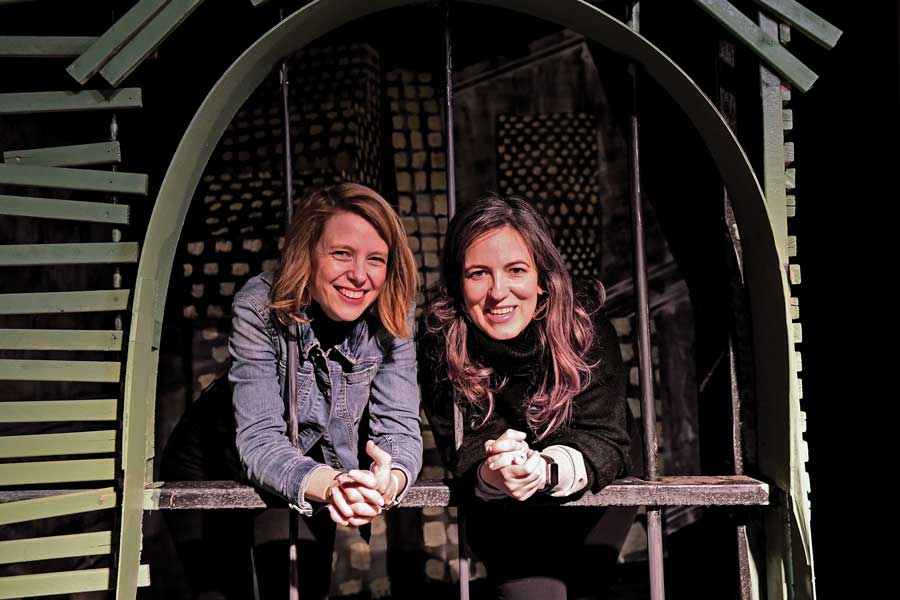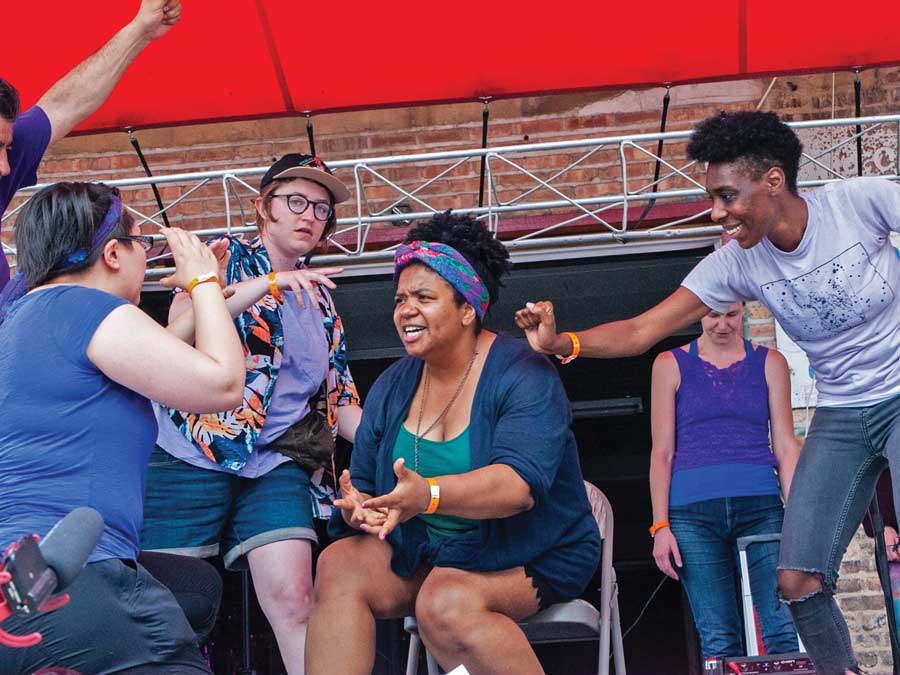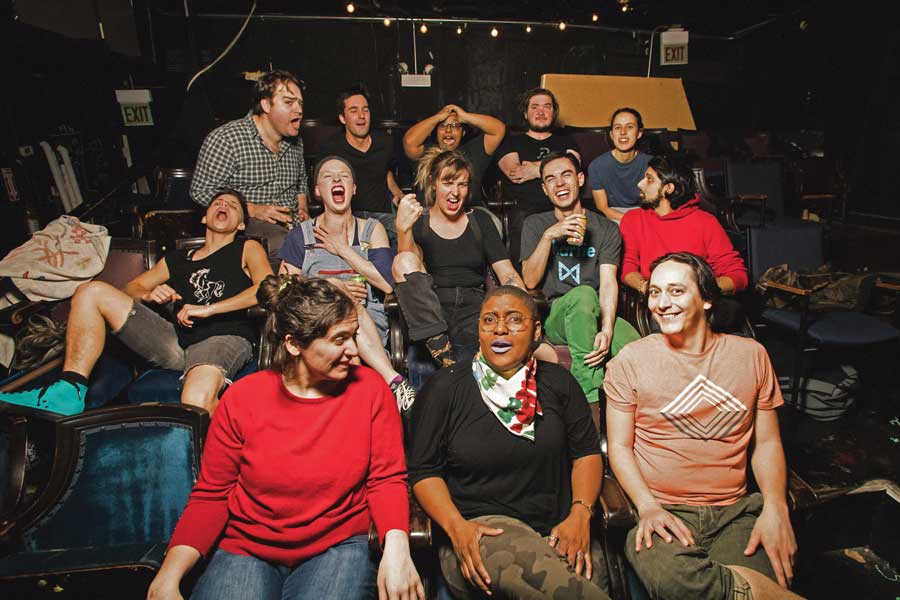This story is part of a package of stories on Chicago theatre. For more, go here.
There is a moment, repeated among members of the Neo-Futurists’ ensemble as they work to agree on modifications they’ll make to their long-running show The Infinite Wrench. It’s a moment that might only attract the notice of an outsider like myself, one I’ve come to call a deferential silence. When Neil Bhandari, who facilitates the meeting, solicits final thoughts from those gathered—fellow ensemble members Joanna Jamerson, Nick Hart, Connor Shioshita Pickett, artistic director Kurt Chiang, and technician Mitchell Chapman—he lingers without speaking well past the point where such a pause would end in most business meetings. At this Wrench pitch meeting, the ensemble decides collectively what one-off structural or tonal elements they’ll be introducing to the show. It’s all part of the Neos’ ongoing effort to keep a nervy, randomized edge to the experience for themselves and their audiences.
In a corporate conference room, such a request for final input might merely be pro forma. But here in this well-loved theatre space called the Neo-Futurarium, a 150-seat venue on the second floor of a brick building at the corner of Foster and Ashland Avenues in the Andersonville neighborhood on Chicago’s North Side, scuffed and chipped by the thousands who’ve passed through over the decades, this question hovers as an actual invitation. Bhandari, and presumably anyone occupying his role in other such meetings, seems intent with this interval of silence on allowing each individual a gut-check about each measure being proposed. In most meetings the words “Anything further?” can have a clipped, conclusive feel, conveying a palpable sense of a hoped-for “no” that preserves expediency and permits the ticking-off of an agenda item. But here inside this stalwart of Chicago’s storefront theatre, there is a discernible sense that all gathered regularly consent—unanimously and in real time—to suspend forward momentum of the group proceedings so that each individual has a chance to turn inward to conduct a frank assessment of the measure proposed, its virtues and pitfalls, and to reconcile it with their own feelings about the show they were all at work creating. Though short in duration, these intervals of silence nonetheless crackle with intellectual and emotional activity, every bit as much as the animated and brainy conversation that surrounds them.
This interval, a moment at once solitary and collective, is emblematic of an ethos that has been developed over several decades across Chicago’s restlessly cross-pollinating performing-arts scene—an ethos that arguably sets this theatre town apart from its counterparts elsewhere. In their recent book Ensemble-Made Chicago: A Guide to Devised Theater, Chloe Johnston and Coya Paz Brownrigg do an admirable job of encapsulating this homegrown approach, and suggesting some reasons for it. Though the volume is primarily a handbook for makers seeking to develop or refine their practice in the collaborative creation of performance work—it’s filled with games and exercises designed to instill trust and deepen risk—it also serves an important archival function. In tracing the aesthetic lineage of many of these warm-ups and drills to their roots, the authors find these roots, often as not, in the radical social justice movements that blazed like a righteous fire through Chicago’s political landscape in the early 20th century. It was a revelation for this reader, at least, to learn how many exercises, now widely used as ice-breakers and team-builders in theatres and workshops across the country, were born not in the ivy-pelted quads of academia but in the sooty, hardscrabble streets where figures like Jane Addams and sociologist Neva Boyd, of the renowned Hull House, a hotbed of progressive activism and social experimentation, worked to improve the lives of poor people and immigrants. Viola Spolin, for instance, now revered as one of the founding luminaries of improv as an art form, was an aspiring sociologist to whom Boyd was mentor and hero.
Not that this sleuthing after the history of these exercises is a dusty academic undertaking. Instead it seeks to uncover a shared set of foundations for work that, on the surface, can seem very dissimilar. Indeed, what Johnston and Paz Brownrigg found as they investigated the source of the exercises was a kind of skeletal structure, not readily visible, that underpins many seemingly disparate forms and traditions in the Windy City. As Johnston puts it, “Philosophically, [these companies] are the inheritors of Jane Addams, in so many ways, but they’re also the aesthetic inheritors of Jane Addams. So we wanted to sort of point out, like, nobody’s thinking about Second City and Albany Park Theater Project in the same breath,” she says, referring to both the town’s local improv giant and a multiethnic youth theatre of long standing. “But look: They came from the same place.”

I spoke with Johnston, an associate professor of theatre at Lake Forest College and a former Neo-Futurist, and Paz Brownrigg, an associate professor of theatre at DePaul University, artistic director of Free Street Theater, and co-founder of Teatro Luna, about their book and about the thinking behind it. In this cultural moment, when so many theatres, not to mention all arenas of our public and cultural life, are grappling with questions of access, inclusion, and representation, it seems an apt time to consider well the insights offered in their lively, informative book.
As with their historical antecedents, many of the companies the authors profile hold themselves and their work to stringent standards of community engagement and radical inclusion, and are resolute in hiring and serving populations often neglected by traditional theatres. Both women speak in unabashedly idealistic tones about the galvanizing power of this approach to making theatre. It is not only deeply democratic, they believe, but also deeply humanist. As Paz Brownrigg observes, “I do think the opportunity we have, as culture makers broadly, is that we can make a version of the world that we want to live in for a little while—we can practice the world we want to live in.”
The book features exercises from and profiles of a great variety of organizations, large and small, that devise original work collaboratively all across Chicago, from established companies like 500 Clown and Lookingglass Theatre, which concern themselves primarily with expanding the expressive possibilities of the stage, to organizations that focus on community and on amplifying the voices of artists typically excluded from the mainstage, like Albany Park Theater Project (APTP) and Free Street Theater, to groups that coalesce around a shared cultural identity, like the LGBTQIA-focused About Face Theatre or the Latinx-driven Teatro Luna. In many respects, location is key: Chicago offers a diverse population, a degree of economic vitality and existing cultural infrastructure but comparatively affordable real estate, which allows such innovation to flourish. Chicago has long been a destination for art makers quite distinct from the big cities on the coasts.
Johnston is matter-of-fact on the topic. “Chicago has this maybe great, maybe dubious distinction, that there’s a real sort of limitation on how much money you’re going to make here. We don’t have Hollywood, we don’t have Broadway, so if you stay in Chicago, you’ve made a certain decision about what’s important in terms of the work you make.”
This tension was expressed by all the artists I spoke with from the companies profiled in the book. Many work a traditional day job, often in the performing arts, but at a much larger institution than the one where they create their own work.
The economic reality of the place, along with its long history as a site for the reform-minded reinvention of many institutions, whether in labor, education, or the arts, combine to form a community of artists singularly well-equipped to plant their feet squarely in multiple contexts. Whether this adaptability takes the form of creating work in the sharply contrasting contexts of large, well-resourced institutions or fringey shoestring ones, or the kind of “code switching” that artists of color do when alternating between primarily white contexts and those where their cultural identity is more robustly represented, there is an expectation that Chicago artists are likely to do a fair amount of this kind of “context hopping,” and nobody, neither artists nor organizations, looks askance. What makes this a distinctly Chicago thing, I think, are the porous borders between high-profile places like Steppenwolf and Victory Gardens and tiny, hole-in-the-wall places like Steep Theatre or itinerant companies like Theater Oobleck. There is often no sharp division between the labor pools at work in these very different worlds.
What’s more, rather than it being a “distraction” or “hobby,” institutions of all sizes here are prone to see artists making and promoting their own individual work as a welcome show of initiative. There is a pervasive acknowledgement on all sides of the symbiotic nature of the relationship between maker and organization.
Paz Brownrigg summarizes it this way: “There are two ways to think about ensemble-made work: One is that it is a small group of people who are designing the work for each other. And by ‘the work,’ I mean a way of working for each other.” The other approach is “a practice that invites new participants, and a remaking of the practice every time you start a new project. There [are] both kinds of ensembles in the book.” She thinks the latter approach offers “such an opportunity to change with the times—to be more responsive to multiple perspectives and possibilities, to intercept problematic power structures quickly. You’re empowering people to speak about it, to change it—empowering people to take on roles that allow them agency, and I don’t just mean roles onstage. I think that that is so much of what we need right now. That is the emergent strategy of, like, what would happen if we reimagine the very way we work? We cannot fix a broken system. I’m not a reformist. That’s where I’m like: Burn it down, start over, 100 percent.”

Both women acknowledge a certain irony in their working for large institutions of higher learning (Paz Brownrigg at DePaul’s conservatory-style theatre program, Johnston at Lake Forest College’s much smaller one, where she teaches in multiple departments). While they work in places with ample facilities and resources of time, material, and money, they are making and studying work that exists largely outside the bounds of traditional theatre, work that often enlists non-professionals and takes place in atypical, informal spaces, on budgets that are microscopic or nonexistent. Much theatre, even in Chicago, still gets made within a “command structure,” in terms of the creative team in the rehearsal room as well as with the administrative staffs of organizations that produce plays—hierarchal settings where individual artists and designers have limited agency or authority regarding the selection, generation, or interpretation of material. Ensemble-created work, by contrast, demands a redistribution of power, a more equitable division of creative agency across all creators involved. Such depth of engagement results in greater intimacy and trust in such collaborations, to be sure. While university theatre programs at high-budget schools can offer students a simulation of the kind of professional experience they’ll have if they land roles at big, high-budget regional theatres (dressing rooms, designers of every specialty, grids crowded with lighting instruments, etc.), they may leave ill-equipped for the bare-bones realities they’re likely to face (communal or nonexistent dressing rooms, self-costuming and makeup, minimal or nonexistent lighting, etc.).
That’s why, in their roles as instructors and mentors to young theatre artists, Johnston and Paz Brownrigg attempt to inject the education of their students with as much of the ensemble-creation ethos as possible, so that their students will emerge more well-rounded in their experience and varied in their expectations of the professional world awaiting them, but also with sharpened critical faculties and greater agency over their own creative lives.
Collaborations in devised work, it must be said, are necessarily very time-intensive—both at the micro-level of the moment, as in consensus-building of the Neos’ meeting described above, and at the macro-level over a rehearsal period. In a traditional process, there’s typically a completed script on the first day and rehearsal can last from three to five weeks, whereas a collectively generative process can last many weeks or months. Paz Brownrigg lamented her chronic inability to work with designers she likes because “they can’t commit to an eight-month process.”
Indeed, like any aesthetic, devised work has its own demands and limitations. Both authors speak of an altered relationship to “process vs. product.” Given the intense climate of discovery that surrounds the development of a project, there’s a risk of insularity. A tendency to deprioritize the “culminating event” can also take hold, and the public performance of the work may cease being the main motivation in some cases. The cognizance of the audience, and the need to deliver a fulfilling experience for spectators, can fade from view in a fluid environment of creative experimentation. It requires a judicious and discerning practitioner to be both able to “harvest” the full benefit of the ebbs and flows of a robust, long-lasting development cycle, and to shape and distill the resulting overabundance of material into a cohesive piece that feels resolved and complete. In an inversion of the usual “director has the final say” model, the process of truly ensemble-generated work requires that each artist both assert their own individual preferences and remain open to everyone else’s views, toggling between the free and wild, the orderly and civil, different regions of the brain firing simultaneously.
I spoke with Mariana Green, a co-founder of FEMelanin, an ensemble of women of color profiled in the book, and she noted one of the defining elements of the form, framing it as both a strength and a challenge. “A single view [of a lone playwright] is very dichotomous, prone to creating heroes and villains, but in devised work, everybody contributes to making the story, so more perspectives are reflected…It’s a lot of work at consensus-building, but it’s really exciting, because every person involved is thinking at a high level about the meaning and the intention of the piece.”
This redistribution of authorial perspective can result in serendipitous, kaleidoscopic thrills as ideas ricochet off each other, but it can just as easily become chaotic and unmoored. Green notes that it’s key to have a shared sense of the project’s goals at the outset so that all the ideas of those assembled can converge in unexpected but fruitful ways.
What about the potential problem of clashing egos? I wondered. Andrew White, founding ensemble member and director of community engagement for Lookingglass Theatre Company, says that when everybody involved can “surrender themselves to the good of the piece and the story we’re trying to tell,” then it becomes easy to “kill your darlings.”
Alexandra Meda, associate artistic director of Teatro Luna, echoed and amplified some of the rhetoric of revolution that guided the social reformers who initially devised many of the exercises in the book. “Creating work in this way makes us bolder—no journey is easy, and failure is obviously necessary for artistic achievement to be possible. If we’re ever going to decolonize the American theatre, to dismantle the white supremacy of all our institutions, we need to invite a greater diversity of voices into every level of the creation of new work, of design and production, and administration.”
It’s worth noting that another recently released title touches somewhat upon similar territory: Mark Larson’s Ensemble: An Oral History of Chicago Theater. I have yet to read it, but it seems more directed at theatre fans interested in a behind-the-scenes glimpse of some of the city’s celebrated companies and personalities. In contrast, Johnston and Paz Brownrigg’s Ensemble-Made Chicago is a guide for both the working professional and the serious student of theatre, here and everywhere. Indeed, as Johnston rightly points out, many of the exercises in it could have a much wider application: “I can see a really great history teacher using this book in the classroom to give students a more immersive experience.” And the approaches it details aren’t just applicable to devised work; a production of Ibsen or O’Neill, say, might just as readily be enriched by a cast that has been granted the agency to generate beats within the confines of the script. Pauses may be filled with greater intention, lines of dialogue and action shaded with truer feeling.
Ensemble-Made Chicago is very much a book that seems intended to function as a “living document”—the kind of well-thumbed volume that lives in a backpack, not on a shelf, one destined to have many notes of agreement and dissent scrawled in its margins, a book that gets pressed into the hands of the artist who feels stuck, the instructor seeking fresh eyes, the student resolved to push themself.
It’s a book for this cultural moment, when every theatre, no matter its size or reputation, must rededicate itself to staffing, programming, and sensibilities that reflect their communities more fully, and when we all must aspire to cultivate greater sensitivity and empathy. It’s an invitation to us, as artists and institutions, to dare greatly, to remain vulnerable before one another, to retain our sense of play, and to summon greater authenticity and connection. After all, as I witnessed in the Neos’ meeting, an interval where we defer to one another and find respectful accord can be a small revolutionary act.
Ian Belknap is a writer based in Chicago.


